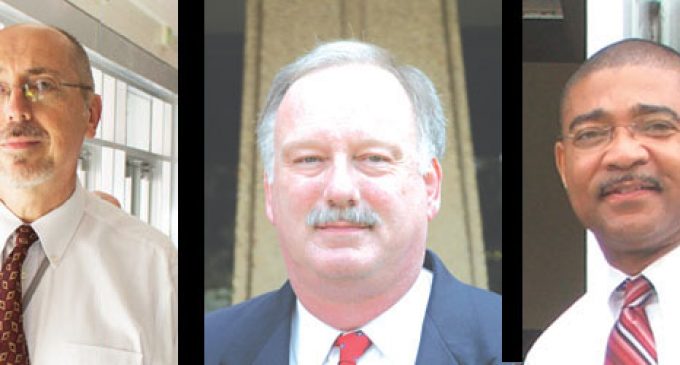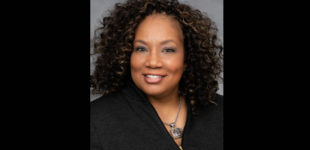Principals: We’re winning the battle

Schools taking special measures to keep graduation rates solid
Four-year graduation rates are up in the Winston-Salem/Forsyth County School District. The rate reached 82.1 percent in 2013, an improvement over its 2012 rate of 80.9 and a jump of more than 11 percent over the rate in 2008.
While all high schools have seen some improvement, those with large African American and Hispanic student bodies continue to experience struggles. Carver High School still has the lowest four-year graduation rate in the county, although its rate, 73.8 percent, is more than a percentage point higher than it was in 2012. Jacket Academy, a specialty education program within Carver’s academic structure, enjoyed a 100 percent graduation rate for the first time in its history. Carver Principal Ron Travis said looking at the two schools’ rates independently is misleading, because most of the Jacket Academy students are integrated into the regular Carver instructional program as well.
“It’s not a separate entity; the teachers share those kids,” Travis explained. “These students were hand picked from the Carver body of students … because (academically) they were middle of the road to high fliers at that time.”
Combined, the Carver Complex achieved a 78.1 graduation rate, still the lowest in the county, but within striking distance of R. J. Reynolds and the Middle College, which reached 80.6 percent and 80.3 percent, respectively. Travis says that number is even higher for students who spend their entire high school career at Carver, adding that the school’s rate is sometimes hurt by students who start out at Carver but transfer elsewhere and don’t finish, as schools are held responsible for all students who start there in the ninth grade, regardless of where they finish.
“The kids here are graduating for the most part. If Carver gets a ninth grader — a true freshman — there’s more than a 90 percent chance that that student is going to graduate in four years,” he said. “…Although we do have some concerns, overwhelmingly we have good, solid students here who go on to a two-year and four year colleges or to the military.”
Carver is striving for a 100 percent graduation rate. Seniors meet with school counselors two to three times a year to identify and address any issues that may keep the students from graduating and PTA President Beverly Bradshaw and Vice President Chemika Richardson are working to engage more parents.
“Children do better when their parents are involved because then they’re held accountable. That’s the culprit to me, parental involvement, because you’ve got to have it in order for children to be successful,” said Bradshaw, whose daughter is a junior at Carver this year. “We struggle with that as a black community. That’s a struggle in our community as a whole, not just with Carver High School, and that’s where me and Ms. Richardson want to make an impact.”
Parkland IB Magnet has improved its graduation rates by 17 percent since 2009. It is now at 82 percent.
“I feel like we’ve come a long way,” declared Principal Dr. Tim Lee. “…We haven’t topped out yet — we still have more work to do — but we’re very happy with the progress we’ve made.”
Lee credits the uptick to several factors: a United Way-funded team of graduation coaches that works with students; Title 1 tutoring programs; and the implementation of Saturday morning sessions for students in detention and those with excused absences.
Other indicators show overall improvement in school performance, Lee said. The number of ninth graders who were retained dropped from 147 in 2007 to 60 students last year, and the Class of 2013 nearly doubled the amount of college scholarship dollars earned by the class four years prior, bringing in a grand total of $9.4 million this year, he noted.
Winston-Salem Preparatory Academy slipped from its flawless graduation rate of 100 percent last year, but remained in the district’s upper echelon with a 94.4 percent graduation rate. The decline was due to two students who did not finish in four years, according to WSPA Principal Richard Watts.
“We still have a good number,” Watts said. “What helps us is we’re small. We build good relationships with the students, the parents and the families and there’s a trust between our high school guidance counselors and the students and parents.”
Atkins Academic and Technology High School held steady with its graduation rate, dropping just 0.7 from its 96.9 rate in 2012 to 96.2 this year. Principal Joe Childers said the school develops four-year plans for each student and all are paired with a staffer for an advisory program.
“All of the adults at our school have 10 or 12 students that they’re personally responsible for that they try to meet with once a month … so that the kids have a personal connection with an adult,” he explained. “We spend a lot of time working at it — it takes extra time to do that — but I think it’s really important to our kids.”
Like many of his colleagues, Childers expressed concern about education cuts that are coming from the General Assembly, and the impact that the measures could have on students and teachers in the public school system over time.
“My concerns moving forward mostly are just what’s going to happen with the legislature, and how much more can they cut public education without there being fallout and without it being detrimental to the kids,” he said. “Every year, every public school in North Carolina is asked to do more with less and I think you’re just going to get to a point where that’s not possible.”
The school system’s Early College program also has a 100 percent graduation rate. The traditional high schools with the highest four-year graduation rates are Reagan and Mount Tabor, which both have rates of 92 percent. West Forsyth’s rate lags behind slightly at 91.9.
School Board Member Victor “Vic” Johnson said comparing the rates of predominantly minority schools to those of predominantly white schools is unfair because of the achievement gap that exists nationwide. Despite the statistics, the district’s magnet schools are faring well and many minority students are excelling, Johnson said, noting that African Americans topped their graduating classes at many of the high schools last spring.
“Most of the kids that got salutatorian or valedictorian, most of those kids were black kids,” he said. “So you’ve got some black kids who are doing very well.”











